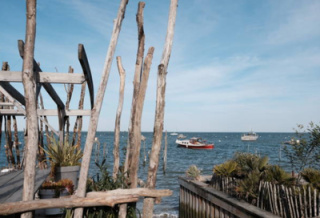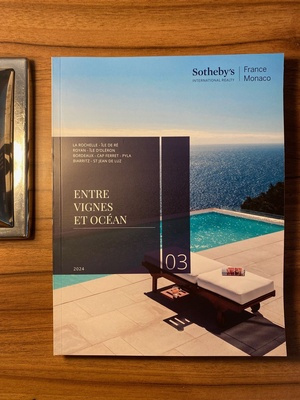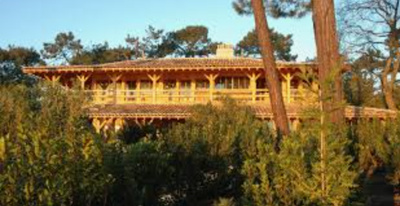Sotheby's International Realty
- 13 Boulevard de l'Océan
- 33115 Pyla sur mer, France
- +33 5 57 72 04 54
Sotheby's International Realty
- 186 bis route du Cap Ferret, Le Canon
- 33950 Lège-Cap Ferret, France
- +33 5 56 60 68 32
Sotheby's International Realty
- 40 Cours de Verdun
- 33000 Bordeaux, France
- +33 5 56 79 63 62
Lège-Cap Ferret: A peninsula rich in history
Trace the history of this wonderful place

This commune in south-west France stretches across a 25-kilometre peninsula, bordered to the west by the Atlantic Ocean and to the east by the Bay of Arcachon. This destination offers a unique panorama, with magnificent pine forests, wild dunes and picturesque villages. If you're visiting one of the properties for sale by our agency, don't hesitate to take a stroll and discover these beautiful villages and exceptional surroundings.
From the first inhabitants to the Lords of Lège:
Traces of human occupation dating back to prehistoric times have been found on the peninsula, including burial mounds and megalithic remains. In the Middle Ages, the region was under the rule of the Lords of Buch, a powerful family who owned vast forest estates. They supported the exploitation of timber and the construction of villages to contribute to the development of the peninsula.
The rise of forestry and the village of Lège:
The village of Lège has a history linked to forestry. Forestry has played a crucial role in the economic and social development of the commune.
In the past, the maritime pine forests of the Bay of Arcachon were exploited for their wood, which was used as fuel, construction material and to produce resin. Forestry activity intensified in the 17th century, with the arrival of Bordeaux merchants who invested in forest management and the construction of sawmills. The 19th century was marked by the growing demand for wood for shipbuilding, and the paper industry stimulated logging. New villages sprang up in the heart of the forests, such as Le Canon and Le Grand-Crohot. Lège became an important centre for the timber trade, with a bustling port and numerous craftsmen.
Over time, the population grew, thanks to the jobs offered by forestry and industry. New infrastructure was built, including schools, shops and churches. The village also acquired a town hall and a justice of the peace. The 20th century saw the decline of the latter, as competition from exotic woods and the arrival of new building materials led to a drop in demand for maritime pine wood. Craftsmen closed down one after the other and the villages where resin was produced were emptied of their inhabitants.
Today, forestry is no longer the main economic activity in Lège. However, its legacy is still present in the commune's landscape, with its vast forests of maritime pines. The village of Lège retains a number of vestiges of its forestry past, such as the old resin workers' houses and towpaths.
The emergence of the oyster-farming villages of Cap Ferret:
Oyster farming in Cap-Ferret has its roots in the 18th century, when fishing families settled on the shores of the Bassin, taking advantage of its nutrient-rich waters to cultivate oysters. The practice was still underdeveloped, with oysters simply harvested from natural beds.
In the 19th century, oyster farming took off in a big way. The growing demand for oysters encouraged oyster farmers to develop more modern production techniques.
This intensification led to the formation of villages grouping together oyster farming families. These villages, such as Claouey, Le Four, Piraillan and Le Canon, L'Herbe ou La Vigne, became centres for this activity, punctuated by the tides and the intensive work of the oyster farmers.
In addition to its economic activity, oyster farming has become a pillar of Cap Ferret's cultural identity. The oyster-farming villages, recognisable by their colourful huts and picturesque alleyways, attract many curious visitors every year, just like you, to discover this unique way of life.
Today, forestry is no longer the main economic activity in Lège. However, its legacy is still present in the commune's landscape, with its vast forests of maritime pines. The village of Lège retains a number of vestiges of its forestry past, such as the old resin workers' houses and towpaths.
The emergence of the oyster-farming villages of Cap Ferret:
Oyster farming in Cap Ferret has its roots in the 18th century, when fishing families settled on the shores of the Bassin, taking advantage of its nutrient-rich waters to cultivate oysters. The practice was still underdeveloped, with oysters simply harvested from natural beds.
In the 19th century, oyster farming took off in a big way. The growing demand for oysters encouraged oyster farmers to develop more modern production techniques.
This intensification led to the formation of villages grouping together oyster farming families. These villages, such as Claouey, Le Four, Piraillan and La Tremblade, became centres for this activity, punctuated by the tides and the intensive work of the oyster farmers.
In addition to its economic activity, oyster farming has become a pillar of Cap-Ferret's cultural identity. The oyster-farming villages, recognisable by their colourful huts and picturesque alleyways, attract many curious visitors every year, just like you, to discover this unique way of life.
The coming together of two villages: Lège and Cap Ferret
In 1976, the previously separate villages of Lège and Cap-Ferret decided to join forces to form a single commune: Lège-Cap-Ferret. This merger marked the recognition of a shared identity forged over the centuries by life by the ocean and the dock.
The merger of the communes was motivated by several factors: preservation of the environment, economic development and improving the efficiency and quality of public services.
An exceptional natural and cultural heritage
Today, Lège-Cap Ferret is a popular destination, appreciated for its unspoilt natural setting and authentic atmosphere. The peninsula is home to an exceptional natural heritage.
If you're into water sports, you're sure to find what you're looking for ! There are plenty of opportunities for sailing, surfing and windsurfing.
From pine forests to oyster-farming villages and wild beaches. This area offers a multitude of landscapes and activities to suit all tastes!







